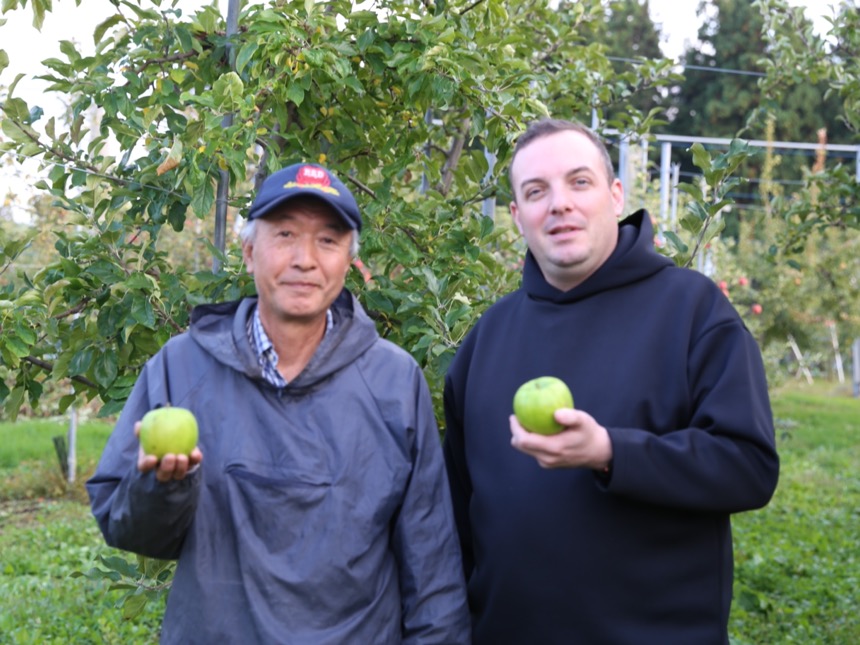Culinary Journey to Aomori Prefecture
Greeting from Park Hyatt Tokyo Food & Beverage team.
The other day, I visited Aomori Prefecture with Ms. Ito and Ms. Akimoto who work with me in the pastry kitchen, along with staff from the Materials department. We gathered at Tokyo Station in the early morning when it was still dimly lit and boarded the first Shinkansen train for a three-hour ride, my first visit to Aomori.
This visit was made possible after I made a plea to the Material Department. One of the items on offer at the Pastry Boutique this holiday season is a Christmas cake called “Bûche Occitane. ” This is one of my creations that combines the rich taste of chestnuts with the acidity of the fruit. It’s covered with blackcurrant and blueberry jam, marron mousse, and flavored with Earl Grey tea. I named it “Occitane” because chestnuts and blackcurrants are famous produce of the Occitanie region in southern France. I heard that Aomori grows high quality chestnuts and blackcurrants, and I was keen to visit in person.
First, we went to the Hiroka/Hirosaki regional wholesale market, which is the largest market for apples in Japan.

Look at this whole area of apples!
We were all awestruck by the variety and quantity of apples we saw for the first time.
On this day alone, about 90,000 boxes of apples were auctioned, and they store a considerable amount too. The vast market was filled with the aroma of sweet and sour apples. The tempo of the auction was so fast that the Japanese staff members who accompanied us were surprised that they couldn’t keep up!
We tasted several different varieties of apples such as Fuji, Gunma Meigetsu, Shinano Gold, Shinano Sweet, Grammy Smith, and Pink Lady. Some of the varieties were new to me and it was interesting and enjoyable to taste the unique characteristics of each. Despite their similar names, “Shinano Gold” and “Shinano Sweet” have distinctly different tastes, and I preferred the sweeter “Shinano Sweet.

Next, everyone moved to “Apple Park” in Hirosaki City for lunch. The 5.2-hectare site is home to 2,300 apple trees, and the “Apple House” facility sells specialty products and offers a menu with items that can only be eaten here. I chose the “Apple Ramen”. The light salt-based soup and the slightly sweet noodles with apples kneaded into them were an exquisite combination.

In the afternoon, we visited “Oguriyama Farm.” We met Mr. Kakuei Kudo, who runs the farm in the suburbs of Hirosaki City, which has long been a chestnut producing area. Mr. Kudo does not sell fresh chestnuts to the market, but instead carefully processes them into a paste and distributes it to confectioners.
I actually tasted the freshly made paste, which is made only from chestnuts and sugar, and it had a very rich and sweet taste, partly because it is the same variety as “Tanba chestnuts”. Since I like both French and Japanese chestnuts, my creative spirit was greatly stimulated. The kindness of Mr. Kudo, who waited for us to harvest some of the chestnuts so that we could experience picking them, was another pleasant memory of the trip.


The next stop was the “Hatsukoi Gurin Association”. In order to stabilize quality, production, and sales, this association adopts a club system, which has recently become common overseas, and only members are allowed to grow “Hatsukoi Gurin”. We interviewed its chairman, Mr. Tomoyuki Kon.


“Hatsukoi Gurin” is a popular green apple known for its crispy texture and slightly acidic taste, as well as its beautiful glossy green hue. I was told that it is rarely distributed in the market for fresh eating because it tends to have dimple-like spots, but it retains its acidity even when cooked, and its rich flavor is accentuated by the loss of moisture, making it ideal for apple pie and tarte Tatin. We are now using this variety for our apple pie at Pastry Boutique.

Returning to the Aomori Prefectural Office, we finally met the members of the “Aomori Cassis Association” and tasted not only blackcurrants, but also pears and ciders. The cool climate is ideal for growing blackcurrants, and Aomori City boasts the largest production of blackcurrants in Japan. Since its cultivation began in 1975, Aomori blackcurrants have been grown without any breeding or other modification, and the strong flavor and rich nutritional content unique to the original variety are the major differences from imported and other varieties. They certainly have a wilder flavor than the blackcurrants I have eaten before, and I could feel their high nutritional value.
Riding the last shinkansen, we returned to Tokyo after 11 pm. Although we only stayed in Aomori for 10 hours, the inspection trip was a fulfilling day full of new discoveries as we fully enjoyed the charms of Aomori. Witnessing the cultivation conditions, the thoughts and pride of the producers, and myself as a chef, I learned a lot and gained a lot of inspiration for my future creations.
I would like to thank the Aomori Prefectural Government and all the producers for their hospitality.
I would also like to thank the team from the Material Department for listening to my wishes and organizing the visit.
Please look forward to this year’s Christmas cake! Happy Holidays!
Park Hyatt Tokyo
Executive Pastry Chef
Julien Perrinet